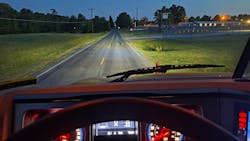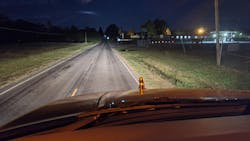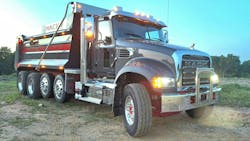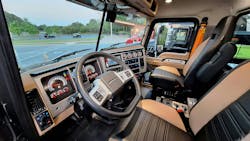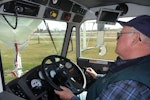Granite LEDs Take Sight Test vs. Halogens
Since its introduction in 2001, Mack Trucks’ Granite vocational model has changed little in outward appearance, even as numerous improvements have been applied under its hood, on its chassis, and inside the cab. Granite works as a straight truck and a truck-tractor, usually outfitted with rugged components capable of running off-road as well as on pavement. Among its construction applications are dump, concrete mixer and pumper, and block hauler.
Early last year, a “refreshed” Granite appeared at trade shows and, after production began that summer, began showing up on work sites and the streets and highways leading to them. The refreshing was pretty much limited to minor exterior styling—a new front “facia” —and a switch to LED headlamps, said Tim Wrinkle, vocational marketing manager, when we met for my look at the latest Granite iteration.
Read Berg's evaluation of Mack's Command Steer, an intelligent variant of the company's power steering.
LEDs (light-emitting diodes)—the main technical change—produce bright white illumination in headlamps that can better reveal the road ahead and any obstacles in and around it. The LED lamps, supplied by Grote, replace halogens of the previous model, which in turn were an advance over sealed beams, a design dating to the 1930s and ’40s. The LED is a type of semiconductor that gives off light when current flows through it. Development goes back to the early 1900s, and LEDs were first used in consumer electronics products in the 1960s, according to Wikipedia. Multiple diodes are used in a headlamp.
The first truck LEDs were red tail lamps around 1990, and Grote was the first to market with them. They were said to use one-tenth the energy and last 10 times longer than incandescent bulbs, though longevity depends on quality. Automobile and truck makers now use LEDs virtually everywhere on and in their vehicles. One characteristic is rich, vibrant color. Another is a cool operating temperature, which indicates low energy use. But that also allows snow and ice to form during inclement weather, so electric heating grids are built into the lenses to melt any frozen moisture.
Comparing LEDs to halogens
My visit to Mack’s headquarters in Greensboro, North Carolina, was timed to include after-dark driving along dark country roads outside the city. Wrinkle had a pair of Granite dumpers ready for driving, which I did first with the latest model, then the previous one, to illustrate the LEDs’ superiority. I did see the whiter quality of LED light, which to my eyes is definitely preferable. But the halogens on the older Granite worked well, too.
There were two reasons the LEDs didn’t appear markedly better in this informal test: There was still some post-sunset light in the sky, so the new truck’s headlamps couldn’t show off their brilliance; LEDs are said to be as much as 50% stronger than the halogens. And they were aimed too low, reducing their effective range, while the older model’s halogens were aimed correctly.
I did see that the halogens’ light was a bit more yellow, but the lamps otherwise did a good job of showing me the road. Had the LEDs in the other truck been aimed higher, I probably would’ve liked them more. Incorrect aiming is easily correctable, so should be on a checklist when a new truck’s owner takes delivery.
Another thing needing adjustment on this refreshed Granite was wheel cut on the steer axle, because its turning radius seemed too large. Yes, you’d expect that with a 20,000-pound-capacity steer axle with its wide tires and wheels. But in designing the Granite axle-forward model six years ago, engineers placed steering gear inside the frame rails rather than outside, as many competitors do. That provides more lateral room for wheels as they swing left or right (and high-capacity steer axles use two sets of steering gear).
When I first drove an axle-forward version in 2018, I was impressed by its maneuverability, which seemed about as good as a Granite with a rear-set steer axle. So the wide radius I found with this new Granite was surprising.
Then I drove the older truck, which Wrinkle said was mechanically a twin to the new one, and hey, its turning circle was noticeable better. This was obvious when going through acute-angle corners and while making a U-turn on a boulevard near Mack’s headquarters. I also recalled when halogen headlamps began replacing sealed beams in the 1980s, and that halogens were so much better. So, “If I had to buy a truck tonight,” I told Wrinkle, “I’d take this one”—meaning the older version of the Granite.
Mack Granite's new styling
The front grille now is wider and its chrome-trimmed bezel, or surround, has lost the V at its upper center, and now runs straight across (the V and the two vertical side bars were supposed to form a big M, but that never visually registered with me). On the hood, air intake panels on each side are now slightly larger and rectangular instead of trapezoidal.
The composite-material hood seems massive when one stands next to it, but it was easy to tilt for views of the engine and accessories, and for pre- and post-trip inspections. The traditional metal Bulldog ornament served as a handle to pull the hood up and forward, and to push it back down. While underway, the dog is an excellent aiming sight; keep it on the pavement’s right edge and the wheels won’t wander onto the shoulder.
The interior was not changed, and that’s a good thing. Its gauges and controls are conveniently laid out in an A panel, directly ahead of the driver, with speedometer, tachometer and a 5-inch digital screen that displays various info of immediate use; and a B panel, angled out from the dash with rows of large rocker switches, and the HVAC controls with three circular knobs, which are easy to see and operate.
Close by are push-buttons to control the mDrive HD automated transmission, with a small red-on-black readout showing which gear the tranny is in. With no load in the dump beds, both transmissions started out in higher gears, 4th and 5th mostly, and skip shifted up to top gear. That’s 12th, but there are two crawler gears labeled C1 and C2, making it a 14-speed.
Also on the B panel is a 7-inch digital color screen that shows, among other things, images from an array of outward-facing cameras. These provide views to the immediate front and sides, and to the rear. While reversing the truck, the rear view superimposes color linear markings as guides to navigate terrain and obstacles. Camera views can be called up and locked in, which would be valuable on a job site so the driver can see into blind spots. And I figured keeping the rearward image on the screen would be a good way to observe traffic behind, though there wasn’t much on the back roads this quiet evening.
How Mack improved the Granite's dashboard
Designers put a lot of thought into the layout of control panels—which we commonly and almost dismissively call “the dashboard” or just “the dash”—to make them convenient and efficient to use. Along with pedals and the steering wheel, they actually link a driver’s brain to the truck and all its systems. The better the design, the more effective and safe the driver’s involvement is.
Unlike automobiles and light trucks, where various functions are fashioned more for appearance and trendiness than practicability, heavy trucks happily stay with tried-and-true designs. And the Granite’s dash is among the best I have seen and used: simple yet attractive, especially when colorfully illuminated at night.
Seats are well padded with just the right amount of bolstering along the edges to provide proper support and comfort, and to keep driver and passenger in place while riding over rough terrain and through road curves and corners. Wrinkle and I did all of that on this night.
Both trucks had top-of-the-line Premium interior trim, with brown and tan fabric, vinyl and leather coverings on the seats, dash, doors and rear-wall panels; two-tone gray is also available. This interior design is shared with other Mack models, including the Pinnacle highway tractor. Most drivers would agree that either of these Granite dump trucks would be a nice place to work. And after further thought, Mr. Wrinkle, I will take the one with those LEDs.

